Its frustrating to spend time caring for your yard and garden to only have a pest come and destroy it.
Unfortunately, its hard to tell which pest is causing the damage because they live underground.
Don’t worry I’ve got you covered. In this post, I will go over the key differences between gophers, moles, and voles so you can determine which one is invading your home.
Once you know which one is invading your house, you can plan your next course of action.
Let’s get started.
Gopher vs Mole vs Vole: Appearance
Determining which pest is destroying your yard is difficult because they live underground and cause similar damage.
If you see a rodent on the surface, below are key characteristics to help you identify it.
What Does A Gopher Look Like?
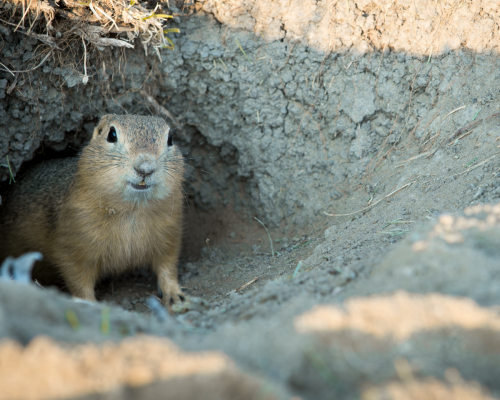
Gophers closely resemble the family of rodents that belongs to mice and rats. They grown to be about 12 inches long.
They can vary in color ranging from dark brown to light brown. They have 4 large exposed teeth.
They have long claws that they use for digging. Gophers resemble mice and rats because they have small eyes, short ears, and long hairless tails.
Gophers are unique because they have pouches on their cheeks that they used to carry food.
What Do Moles Look like?
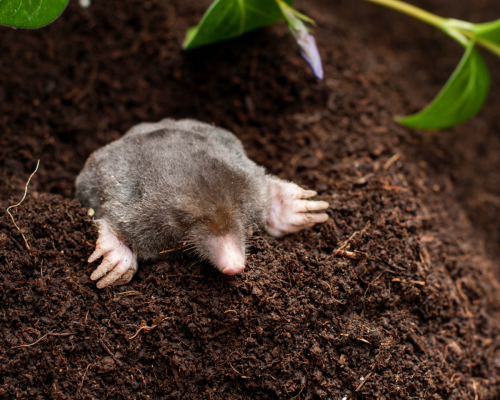
Moles are unique animals. If you were to see one, you would immediately know that it’s not a gopher.
First, moles are smaller than gophers, measuring between 4 and 8 inches. They have unique paddle-shaped feet and large claws. Their feet and hands are large and white in color that makes them easy to spot.
They also have a unique face, which includes a long and narrow head and snout. They have tiny eyes that are nearly impossible to see and no external ears.
Moles are black, and their fur has no grain, which helps them navigate their underground tunnels.
There is one unique species of mole, which is the star-nosed mole. Unlike other moles, as the name suggests, instead of a flat snout, this mole has a star shaped nose.
What Do Voles Look Like?
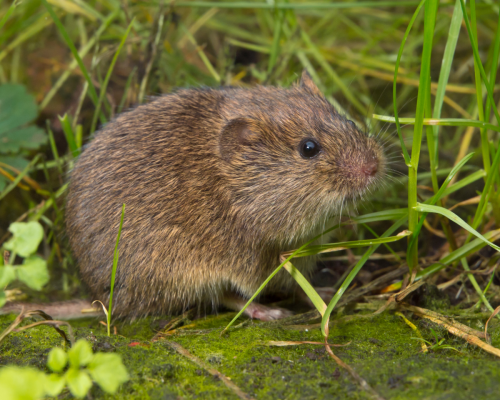
Voles grow to be around 5 to 8 inches in length. Voles have short, stocky bodies, with small eyes, and large, fully developed ears.
They have thick fur that can vary from light brown to gray. Voles, compared to moles and gophers, are the smallest of the three.
Gophers and voles are often confused due to their similar appearance. The key distinction between gophers and voles is that voles are smaller and do not have exposed teeth.
Gopher vs Mole vs Vole: Tunnel System and Mounds
Gophers, moles, and voles are the most common ground-dwelling animals in the united states. They are known for leaving mounds and tunnels wherever they go.
Most people can’t tell them apart, but each has distinct characteristics when creating tunnels and mounds.
Without seeing these animals, you can determine which one is invading your yard just by the tunnels and mounds they leave behind.
What do Gopher Tunnels and Mounds Look Like?
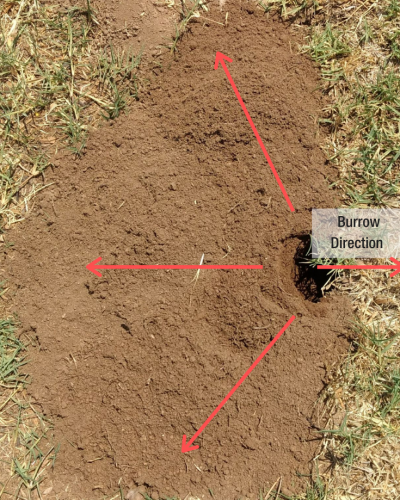
Gophers are often the first animals most people think of when they see tunnels or mounds in their yard.
Gophers, unlike moles and voles, create tunnels that are at least 6-12 inches underground. As a result, in most cases, you will not see any signs of tunnels if you have a gopher.
The only signs you will see from a gopher are mounds.
Their mounds are unique in that they leave a fan shape. The fan shape is because gopher tunnels do not come directly from underground.
Gopher tunnels are angled and come in at a lateral angle.
You can use the shape of the mound to determine the direction of the tunnel below. First, the direction of the tunnel is perpendicular to the side of the fan or dirt.
What Do Mole Tunnels and Mounds Look Like?
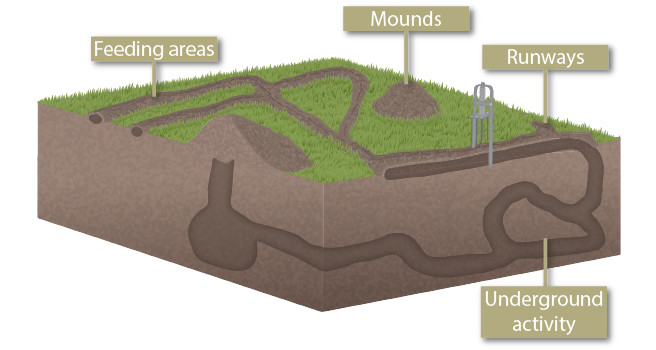
Moles, unlike gophers, create tunnels that are right below the surface. This means that it’s not uncommon to see signs of mole tunnels from the surface.
Mole tunnels also tend to cause the grass above the tunnels to die. This happens because as the moles dig, they destroy the grassroots, causing them to die.
It’s important to note that signs of mole tunnels are not always visible. But in most cases, putting pressure above an area, you suspect mole tunnels will cause the ground to go inwards. If you pushed hard enough, the tunnel could collapse.
Mole tunnels are also unique. First mole tunnels appear as small volcanoes. There will be soil around the entire mound and an entrance hole at the center.
Unlike gophers, mole holes do not indicate a direction.
In some cases, the mole mounds may not have an entrance. In this case, it’s easy to determine a mole mound because they are uniform mounds with the ground lifted above the ground.
What Do Vole Tunnels and Mounds Look Like?
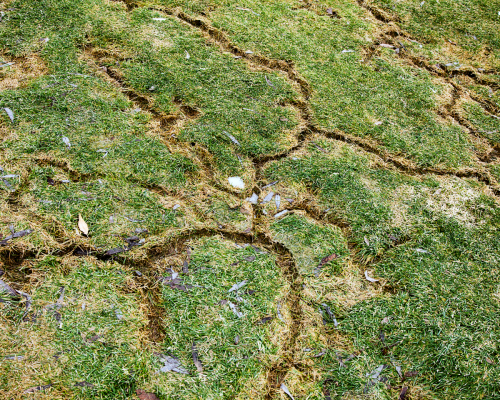
Voles leave the most visible and damaging tunnels out of both gophers and moles.
This is because voles typically create their tunnels on the surface of the soil. They typically eat through grass. These above ground tunnels typically lead directly to a burrow entrance.
Burrow entrances are holes in the ground that will not have any mounds like those produced by gophers and moles.
These holes are flush with the ground. Burrow holes are common near rocks, or under fresh shrubs and bushes where the animals can live under.
The burrow is similar to the nesting location of gophers and moles.
Its possible to find multiple borrow entrances very close together. Burrows tend to be around 12 inches deep and this is where the voles will live and stay when they are not above ground.
Gopher vs Mole vs Vole: Distribution
Where Do Gophers Live?
Gophers are typically found in North American and Central America. Gophers prefer soft, sandy soil that allows them to dig tunnels easily.
They are known for creating intricate tunnel systems under neat houses and gardens.
What Do Moles Live?
If you are thinking of moving to escape from moles, then your choices are quite limited. Moles are found in every continent except South America and Antarctica.
Moles can live anywhere there is soil, but they do prefer to live where the soil is moist and soft to allow them to create tunnels.
Across the world, they are common in a wide variety of areas, from urban areas, grasslands, sand dunes to woodlands.
Moles are versatile creatures that are capable of surviving and thriving in different environments.
They do tend to avoid mountainous areas or areas with acid soil. But, these conditions do not necessarily imply that you will not find moles.
Another unique feature about moles is that they tend to live alone. Most people believe that there is typically only 1 or 2 in the area if you experience a mole in your yard. Most professionals would suggest that a populated region will have less than 5 moles for every acre of land.
Most moles do not interact much with other moles. Compared to other animals such as gophers and voles, they spend most of their lives underground and rarely come to the surface.
Where Do Vole Live?
Voles are found in different parts of the world including North America, Central America, Canada, Asia, and Europe.
They prefer areas with lots of green vegetation. Unlike gophers and moles they survive of the lush green vegetation and do not rely on eating small insects.
Due to this fact, voles can live nearly anywhere there is vegetation. Though they do prefer areas such as grassy fields, meadows, or vegetation near water sources such as lakes and rivers.
Voles are unique in that they spend a much more time than either gophers or moles on the surface. It’s not uncommon to see voles on the surface running around and seeking refuge in their burrows.
Gopher vs Mole vs Vole: Diet
What Do Gophers Eat?
Gophers are unique because they only eat plants and do not eat any insects when creating their tunnels.
They are herbivores, and they eat mostly plants. The most common source of food for gophers are plant roots and grass.
Gophers will typically leave their tunnels to find potential sources of food. To do this, Gophers use feed tunnels.
These are tunnels made to gather food. They often try to place this as close to a potential food source as possible.
Once they find food, they either place it inside the pocket on their mouth’s interiors or drag it directly into their tunnels.
What Do Moles Eat?
Moles are insectivores; they primarily eat insects inside the ground as they dig their tunnels. This typically includes insects, grubs, and earthworms.
Moles are voracious eaters; they can eat about 60% to 100% of their body weight in a single day. This amounts to a 2-ounce mole eating approximately 20 pounds of insects each year.
Moles will not exit their tunnels to eat. They rely entirely on insects and other small animals in the soil.
What Do Voles Eat?
Voles have a wider pallet than moles and gophers. Voles eat a variety of plants, roots, and rhizomes. They can also eat seats, crops, and bark. Voles will also eat insects, and other animal remains if necessary.
Voles are active during the day and night. They remain active year-round and do not hibernate.
Voles require a consistent source of food throughout the year.
This is one of the reasons that voles have such a wide array of food choices. They can adjust what they eat depending on the season and availability.
Gopher vs Mole vs Vole: Behavior
How Do Gophers behave?
If you have gophers, these are some key behaviors you should be aware of and look for:
- Gophers do not hibernate – they are active year-round. They are also active during the day and night.
- Gophers can establish densities as large as 60 gopher per acre.
- Gophers reach adulthood after one year and can live as long as three years.
- Gophers can produce between 5 and 20 young each year. Breeding is highly dependent on water availability. When water is plentiful, they can produce between 15-20 young each year.
- Gophers live most of their life in their tunnels.
- They are not social creatures and do not share burrows. They are known to allow other creatures to live inside their burrows.
How Do Moles Behave?
If you have moles, there are some key behaviors you should be aware of.
- Moles live on every continent except Antarctica and South America.
- Moles create extensive tunnel systems. Their tunnels have special chambers for bedrooms, bathrooms, food storage chambers, and birthing rooms.
- They aren’t blind. They can only see light and movement.
- During mating they have 3-4 hairless babies with each litter. Moles leave their parents and develop new tunnels after six weeks.
- Moles are active year-round but experience reduced activity during extreme cold and heat.
- Moles only socialize when reproducing. With one exception, the star-nosed moles are social and live in colonies.
- Moles spend most of their time creating tunnels and searching for food. They can dig between 10 feet and 20 feet per hour.
- Moles rarely eat plants or roots, but their tunnels can damage or kill grass and plants.
How Do Voles Behave?
If you have voles, here are some key behaviors you should be aware of.
- Voles are active during the day and night. They remain active year-round, even during harsh weather conditions.
- Voles are social creatures, and one burrow can house several young and adults.
- Most burrow systems are relatively small compared to gophers and moles. They typically stretch several hundred square feet.
- Voles breed rapidly and often. They reach sexual maturity within 40 days and can have between fifteen and sixty young every year.
- They don’t climb and remain in grassy areas.
- Voles have a short lifespan and typically only live 12 months to 18 months.
Gopher vs Mole vs Vole: Damage
What damage Do Gophers Cause?
Gopher damaged is pronounced. They eat plants, which means they cause direct damage to your gardens and trees.
They also know for killing grass and leaving large mounds across your yard.
Gopher mounds and tunnels can disrupt irrigation processes leading to soil erosion.
They also tend to chew on plastic damaging irrigation systems and sprinklers.
What Do Damage Do Moles Cause?
Mole tunnels can destroy and damage grass, gardens, and roots.
One of the most pronounced types of damage is surface runways. These are visible from the top surface and look like tunnels under the surface of the grass. These are known as shallow tunnels.
They also create deep tunnels. On the surface, deep tunnels look like large dirt mounds.
Gopher vs Mole vs Vole: Elimination
How To get Rid of Gophers, Moles, and Voles?
Live Traps
One of the most common ways to get rid of moles, gophers, and voles is to use traps.
You would place these traps on an active gopher, mole, or vole tunnel and wait for it to come in contact with the trap.
Most traps are designed to kill these rodents instantly. But there are some live traps that will allow you to relocate them to a different area.
The placement and position of the trap will depend on if you are trying to get rid of moles, gophers, or voles.
Since the tunnels of moles and voles tend to be closer to the surface, traps can be placed on their tunnels.
For gophers and in some cases moles, the trap needs to be placed in exit/entry points.
Since gophers tend to create tunnels that are deep underground the best change of trapping them is to trap them when they are leaving their tunnel.
A common method is to place a trap and then cover the entrance point. This will prompt the gopher to fix their entry point and remove the dirt. The idea is that when they do so they will walk directly into the trap.
Use Repellents
Another way you can get rid of moles, gophers, and voles are by using repellents. Spraying or using repellents in your yard is a great and natural way of getting rid of rodents from your home.
Remember to reapply often because it’s very likely that the rodents will return once the repellent’s potency has faded.
You can use natural repellents such as essential oils, vinegar, or other ingredients to keep gophers, moles, and voles away.
Keep in mind that these are typically not as effective as using chemical repellents.
Chemicals repellents are more effective but contaminate your yard and can make it unsafe for a certain period.
Although chemical repellents are typically stronger, they do typically need reapplication as well.
Chemical Treatment
Another alternative to getting rid of moles, voles, and gophers is using a chemical treatment. This treatment typically involves trenching the soil to create a toxic barrier.
When the rodent burrows through the infested tunnels, they will come in contact with the rodenticide.
Using chemicals is much more intrusive, and more precautions need to be considered.
For edible plants, these should not be planted in soil that will be treated. It’s advised to keep them untreated and only treat around it.
Also, remember to follow the safety instructions regarding when children and pets can resume normal activity.
Flooding
The final way you can get rid of gophers, moles, and voles are by invading their tunnels and nests.
This can be done using several different methods.
First, you can use a water hose to fill their tunnels with water until they either drown or crawl out of an exit hole.
When doing this, it’s important to either keep all the tunnels covered or watch the tunnels to determine where the rodent tries to escape from. This is an all-natural way to get rid of rodents underground.
When using water, remember that this method is not always effective. Depending on how intricate and large their wood tunnels are, it may require lots of water before anything happens.
Fumigation
As an alternative, you can also fumigate their tunnels.
This involves covering any tunnels you see. Then placing the fumigant into one of their entry points.
Let the fumigate work its magic inside the tunnels. The amount of time each fumigant needs to work will vary.
This method is ideal because the gophers will die in their tunnels and you don’t need to deal with dead rodent bodies.
The rodents will decompose naturally inside their tunnels.
